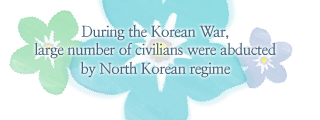Name: admin
2014-01-14 09:59:21 | Hit 1493
Yonhap News, Sep. 15, 2009
"President Syng-man Rhee's government blew an opportunity for the abductees and their families to exchange letters"
The Korean War Abductees' Family Union, or KWAFU, published Korean War Abduction Sourcebook Vol.2 this week, three years after the publication of the first volume in 2006. KWAFU President Lee Mi-il urged the government and society to pay more attention to addressing the issue of Korean War abductees.
The second volume contains a list of 11,700 abductees whose names were included in the civilian abductees list published by the Ministry of National Defense in 1963.
On the 14th, Ms. Lee said, "We acquired a list of abductees' names from the Defense Ministry and compared it with our list of Korean War abductees. In the Defense Ministry's list, the names were recorded up to "Lee" in Korean alphabetical order. This list is the final version of high-quality list that has been updated by the government since the war and includes only people who were abducted by North Korea, excluding people who joined the voluntary army."
She also said, "The abductees' families have been victims of guilt-by-association, just like the families of the people who voluntarily defected to North Korea. A newspaper article in the Sourcebook shows the social atmosphere at that time. It said that, since North Korea was sending abductees back to the South as spies, people should report them."
The abductees' families who were silenced by fear started to regain their voice when the Kim Dae-jung administration came to office. The new government was criticized by conservatives as a "pro-Pyongyang government" for its policy of embracing North Korea. It is utterly paradoxical that the abductees' families were able to claim their rights only after a "pro-North" administration came to office.
According to the sourcebook, it was 1956 when discussion on the abductee issue first took place between the Korea National Red Cross (KNRC) and the North Korean Red Cross.
The KNRC asked the North Korean Red Cross to identify 7,034 Korean War abductees via the International Committee of the Red Cross (ICRC). The following October, it received a reply from the North with the first list of 337 abductees who were confirmed to be alive.
This fact is also included in "100 Years of the Red Cross Movement in Korea" published by the KNRC.
However, the Rhee Syng-man government told the abductees' families only whether the abductees were alive or not, and did not disclose how they were living in North Korea.
KWAFU President Lee Mi-il assumed the reason was that North and South Korea were engaged in a fierce ideological confrontation and the South was poorer than the North at that time.
A source from the KNRC reads, "the government released the first and the second list of survivors delivered from the North, but no further information on the remaining abductees (p. 252).”
Ms. Lee said, "Newspaper articles published at that time show that the ICRC actively arranged a regular exchange of letters of 25 characters or less between the abductees in the North and their families in the South.
But Rhee's government, which thought that the South was in weaker position from every perspective compared to the North, did not accept this arrangement out of fear of the North Korean regime's propaganda and agitation. It is regrettable, because if the letter exchange had been allowed, the state of the abductees' families would have been very different.”





















 FAX : (82)31-930-6099
FAX : (82)31-930-6099
